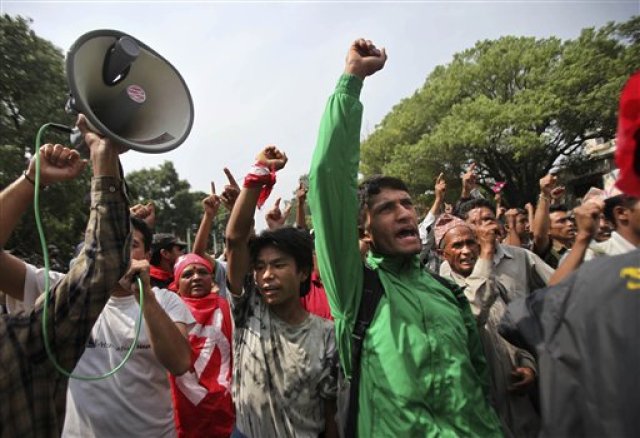
Acting Nepali Prime Minister Madhav Kumar Nepal has argued that bullets, explosives and other munitions no longer constitute “lethal military hardware” as long as they are to be used for “training and other related works”.
MK Nepal was seeking to justify the decision to allow India to resume arms supplies to Nepal. He has never been elected and came to power after the Maoist-led government was brought down by a soft military coup in 2009.
This decision, reported in the January 17 Indian Express, violates the 2006 peace accords that ended the decade-long armed conflict between the Maoists and the then-Royal Army.
In constitutional assembly elections that replaced the centuries-old monarchy in 2008, the pro-poor Maoists won the largest number of seats.
However, royalist army officers refused to abide by the peace accords that required the integration of Maoist fighters into the military.
Together with pro-status quo parties, they maneuvered to bring down the Maoist government. However, Maoist-led mass protests, blockades and strikes have paralysed the government. The Nepal-led government was forced to resign last May, but continues to act as an “interim government”.
The nation is on a knife’s edge, with the real danger of civil war if the political crisis, caused by the unwillingness of the status quo parties to accept the popular will, is not resolved.
United Communist Party of Nepal-Maoist leader and former prime minister Prachanda lodged a complaint with Nepal on January 18 over the importing of weapons from India.
MK Nepal did not deny that military hardware was now being imported into Nepal, but sought to assure the UCPN-M that all imports were “necessary to conduct military drills and training and other related works”.
The resumption of arms shipments from India is further evidence the political process in Nepal is coming apart at the seams. It comes immediately after the United Nations Mission In Nepal (UNMIN), which was a limited mission to aid with the peace process, was forced to leave Nepal.
The interim government has refused to extend the UNMIN’s mandate.
UNMIN is leaving before the integration of the Maoist People’s Liberation Army (PLA) with the old royalist military has taken place — as it was supposed to under the peace accords. It also leaves before a new constitution has been created — or even a new government formed.
The PLA has agreed to stay under the official control of the Army Integration Special Committee. However, the Nepal Army has refused to do so and has also refused to allow its arms to be monitored as per the peace agreement.
In the constituent assembly, there have now been 16 attempts to elect a new prime minister since May. This is due to political infighting of the establishment parties and their refusal to allow the “progressive block” led by the UCPN-M to form government.
The assembly’s term expires on May 28. It does not appear to be even close to finalising a draft constitution, despite already having extended its tenure once already.
At an institutional level, the “New Nepal” process seems to be in trouble. But at a popular level, the process is very much still in motion.
During the past year, there were the biggest popular protests and strikes since the 2006 Jana Andolan (“popular power” uprising) that brought down the monarchy.
Localised struggles are ongoing, with continuing land seizures by poor peasants, and student and worker struggles across Nepal.
In December, the Maoist-aligned All Nepal National Independent Student Union-Revolutionary (ANNISU-R) held a national conference. More than 2000 delegates from across the country took part and about 30,000 students attended the televised opening session.
Over a week of discussion, the organisation elected a new leadership and made plans to involve students in the ongoing political process. Particular attention was paid to finding ways to increase the involvement in the organization of women, those from low castes and ethnic minorities.
The student conference came shortly after the UCPN-M held a national plenum of 7000 members in the mid-western Gorkha district to make plans for the coming period. This will be followed by regional conferences, the first of which was held in Newa State and attracted close to 5000 local activists.
These contrasting events clearly show two very different futures for Nepal. On one hand, the military and pro-elite forces are refusing to recognise the popular will and are violating the peace accords.
On the other, there is mass involvement and participation of Nepalis, inclusion of women and other oppressed groups, and broad community organizations to seek to advance the struggle to create a genuinely new Nepal based on principles of democracy and social justice.
Nepal’s future hangs in the balance between these two forces. The current situation is unsustainable and must be resolved, one way or the other.
With the constituent assembly coming to an end in May, with no constitution in sight, there will be potentially decisive moves from both sides to define what the “New Nepal”will look like.
[Ben Peterson attended the ANNISU-R conference on behalf of the socialist youth organisation, Resistance.]